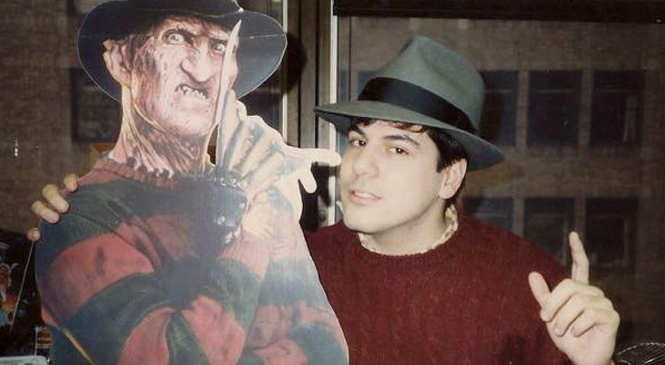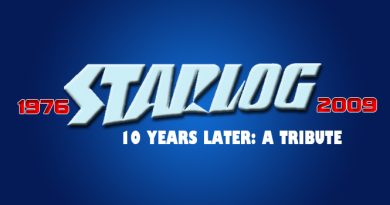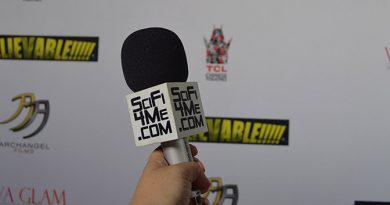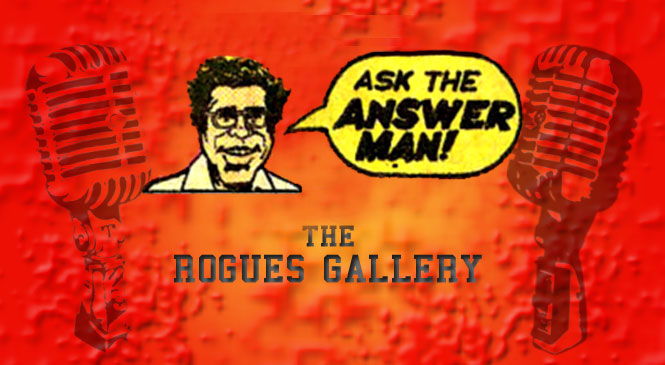Carr D’Angelo: STARLOG Was “The Top of the Heap”

Carr D’Angelo sits in his office at home in California, pictures of the Flash and Superman on the wall, along with what appears to be a lamp in the shape of Galactus’ helmet, and recounts how he applied for a job at Starlog – twice.
Two for One
“I was always more of a comic book fan, and I had a subscription to the Comics Buyers Guide. And [Starlog managing editor] Dave McDonnell took out an ad there, that they were looking for an editorial assistant. And so I think to Dave I wrote a very targeted letter and resumé saying this would be a great job, and not only did I have the proofreading and editing type skills they might be looking for, but I also had a love for the medium and science fiction and all that kind of stuff. And at around the same time, I had answered a small ad in the New York Times that simply said – and it was a very bizarre ad because… I mean the ads in the New York Times, they were classifieds, so they’re not full paragraphs. But it literally said something like ‘magazine publisher, sci-fi, horror, wrestling, soap opera needs editorial assistant’ and it was sort of like ‘OK, maybe I’ll try that, too’ Who knows? That could be anybody, right?
“Well, it turns out, it was also Starlog.”
D’Angelo had cut his teeth with the high school newspaper and fanzines, and during the summers he worked for a public relations firm. There, he discovered that he had a “marketable skill” as a copyeditor and proofreader, which is what led to the search for a job doing that in the New York publishing industry. So it’s no surprise that when he started at Starlog, that’s a lot of what he did. “The major part of it initially was major proofreading. I mean, you’re part of the defense line of just making sure stupid mistakes don’t get through.” Back then, writers weren’t working on computers that called out their spelling and grammar errors. It was the job of the editorial department to make sure the articles were ready for public viewing, and the first step of that process was reading. And reading. And reading.
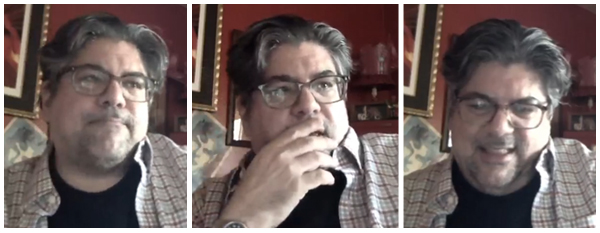
“There were so many different places where the words could go wrong; that was the first job. But it meant reading for all the magazines they were doing, so it was kind of a slog, especially for some of the wrestling stuff, which wasn’t really the most well-written, and there was always that balance between ‘how much do I want to make suggestions?’ or ‘how much do I wanna just make sure it is in some form of readable English and things aren’t misspelled?’ But we did it for all the mags. Starlog, Fango, all the wrestling mags, and again there were various teen magazines and things like that.”
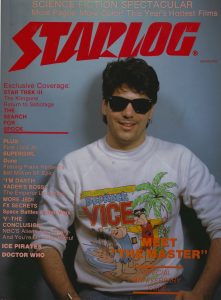 In those beginning days, though, D’Angelo had a favorite element of his job: writing the photo captions. Starlog was one of those few places where you could find photos from classic science fiction movies and television shows, “…and that’s a selling point of the magazine, that you could get these images for your collection, that you wouldn’t necessarily be able to find.” D’Angelo got assigned to write captions for a special edition The Women of Science Fiction. “So of course you’re gonna have Carrie Fisher in the Leia bikini, one of those shots, you’re gonna have from Buck Rogers, Erin Gray as Wilma Deering. And I think they added a page or two, they’d set it up for three pages, and then something fell out so they needed five pages of pictures and captions. So Dave gave me a folder of pictures, said ‘write some captions’.” D’Angelo worked to make his captions similar to the ones McDonnell wrote, saying that he held to the principle that people were in his position before he had it, and others would follow, so there needed to be some continuity in the style.
In those beginning days, though, D’Angelo had a favorite element of his job: writing the photo captions. Starlog was one of those few places where you could find photos from classic science fiction movies and television shows, “…and that’s a selling point of the magazine, that you could get these images for your collection, that you wouldn’t necessarily be able to find.” D’Angelo got assigned to write captions for a special edition The Women of Science Fiction. “So of course you’re gonna have Carrie Fisher in the Leia bikini, one of those shots, you’re gonna have from Buck Rogers, Erin Gray as Wilma Deering. And I think they added a page or two, they’d set it up for three pages, and then something fell out so they needed five pages of pictures and captions. So Dave gave me a folder of pictures, said ‘write some captions’.” D’Angelo worked to make his captions similar to the ones McDonnell wrote, saying that he held to the principle that people were in his position before he had it, and others would follow, so there needed to be some continuity in the style.
An Offer He Can’t Refuse
About six months later, editor Howard Zimmerman left the magazine, with Dave McDonnell moving into the position and leaving the job of Managing Editor open. Zimmerman’s departure was a surprise. “Howard had been there forever, Dave had been there for a long time. It didn’t seem like that magazine was something that was evolving, you know? Fangoria – when you walk into a place you think ‘this is how it is, this is how it’s always been’ and it was a sudden surprise that Howard decided to move on.”
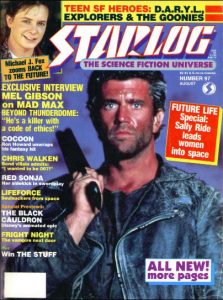 McDonnell called D’Angelo into the office to offer him the managing editor position. “Who would say no? And that also meant, what I liked about that, is it really meant my primary focus became Starlog, and I didn’t have to deal with the wrestling stuff and all the other stuff that was … it needed to be done, but it was not as interesting work, on a basic level.” Starting with issue #97, D’Angelo worked with the writers more frequently, doing a lot more copyediting, and working to make the articles fit the magazine.
McDonnell called D’Angelo into the office to offer him the managing editor position. “Who would say no? And that also meant, what I liked about that, is it really meant my primary focus became Starlog, and I didn’t have to deal with the wrestling stuff and all the other stuff that was … it needed to be done, but it was not as interesting work, on a basic level.” Starting with issue #97, D’Angelo worked with the writers more frequently, doing a lot more copyediting, and working to make the articles fit the magazine.
“The fun part was coming up with some clever title ideas; you couldn’t do just one. It was like you’d be in advertising. It’s like you have to pitch two or three things. And then the slug lines that kind of introduce the articles, and doing the little cute headers that break up the articles and may have a running joke. If you could think of a really good pun to build that around – I’d spend an hour just trying to make sure ‘OK, if I can hit this beat, one, two, three so maybe by the last one maybe someone would get a little chuckle, it’ll have been worth getting through the whole article.’ And while D’Angelo would occasionally get a writing assignment as well, for the most part his work focused on getting everyone else’s articles ready for publishing.
The challenge for D’Angelo, as he dove deeper into editing for Starlog, was the fact that there were some franchises he didn’t know very well. “The hardest part with Starlog stories was more when it was things I just really didn’t know about. Because partially you’re proofreading, but you’re also trying to do some sort of fan fact-checking.” D’Angelo was unfamiliar with many of the British programs, in particular. “At that time I did not know a lot about Doctor Who and Blake’s 7, and so sometimes … you want to be interested in an article, but if you’ve really got no frame of reference, having never seen a particular show, and they’re talking about characters or they’re talking about relationships that presumably anybody who would pick up the article would already know. Because why are you reading an article about Blake’s 7 if you didn’t know? So they’re gonna know about this in-joke or this relationship. But for me, it just kept going over my head, and so it’s hard to know if it’s a good article or not sometimes. So you have to hope that it’s working for the audience.”
Not only were the British shows unfamiliar territory, but so was the original Star Trek. “I loved the Star Trek movies. I was always more of a movie fan. For TV and stuff, as a kid, I was watching more comedies and Batman and Superman. And Star Trek and hour-longs just weren’t my thing. So I wasn’t that intimately involved with Star Trek, but I knew all the relationships because I knew the movies – Wrath of Khan and all the movies were great. So I used that as my basis, but it was around the same time as – again, it’s the ancient path, where VHS and Blockbuster and video rentals were of the day, and I think the Star Trek episodes were one of the first things that came out on video, and they would do two-episode VHS’s. So yeah, if I knew we were doing a series on a certain actor, or an interview or something coming in, I would go down and I would usually, once a week or a couple times a month, I would grab some Star Trek episodes and watch them.”
Oddly enough, whenever he tried to catch the show on television, it always seemed to be the same episode: “The Enemy Within”, in which Kirk is split into two opposite halves by a transporter accident. “For whatever reason, every time I turned on Star Trek that was the one that was on. And there’s Kirk, and he’s dancing with himself, you know, struggling with himself, and it only seemed that I saw that one episode over and over…”
And sometimes, no amount of prep work can leave you ready for an interview, as D’Angelo discovered on the set of Alien Nation, starring James Caan and Mandy Patinkin. “I got assigned what was called ‘the whole package’ – you do a set visit, you talk to all the stars, you talk to the producer, I talked to the production designer – so Starlog would normally try and get six or eight articles out of that, which is pretty good, because after maybe a couple of weeks visiting and talking to people, I would have about six or eight assignments over the next few months to write up.”
Caan and Patinkin had bonded over the fact that Patinkin’s character was going to go by the name George Jetson. However, rights issues prevented the use of the name (it was a Fox movie, but Hanna Barbera and Universal owned the Jetson character). Neither Caan nor Patinkin seemed thrilled to be in the film once cameras were rolling. D’Angelo describes a moment when Patinkin is pounding the table in frustration that he wouldn’t be able to play the pun and be George Jetson. “It just seemed like there were two guys who felt they were sold a bill of goods, and then got there and it wasn’t the movie they wanted it to be, and I think that really makes it hard.”
Asking the Right Questions
One part of the process D’Angelo appreciated: Dave McDonnell’s assignment sheets. “It was a printed form that he would fill in, but if you ever see one – I don’t know if I have one anywhere – but if you ever see one, it’s like he can’t stay within the lines, because he fills it all out, all the questions he wants, he lists all the relevant credits, and then it would just sort of go up in the margins and snake all over the place. And it would be great, because he let his expectations be known.” All of the reasoning behind the purpose and goals of the interview would be spelled out, because sometimes the interview would be with someone who was promoting a project that wasn’t genre.
“I think one of my first assignments was interviewing Peter Coyote, who was Keys in E.T. which is sort of a minor role in the movie, but it’s E.T. and it’s a major science fiction movie, and he was in town for some crime movie with Jeff Bridges… was it [directed by] Joe Esterhaus? Jagged Edge.
“So it’s not a movie that we would cover at all, but he was in town for the press for that, and I think the main actors were probably doing the major interviews, and whoever was handling it for the studio offered it up, or Dave knew that Peter Coyote was in town, and so put us on the list.” D’Angelo says it was a good trial run for him in the interview space, and his prep for that interview was very much like all the others. “I think I had seen E.T. enough times, but we saw the movie Jagged Edge and you just sort of think about – my preparation was always to try and think about those questions that other people haven’t asked.”
In that search for the unasked questions, he looks for connections between the subject of the interview and the work being promoted. “I’d rather talk about something inside the movie that gets them talking, because they’ve spent a lot of time thinking about the character, whatever. And I hate, especially when I watch in the era of Entertainment Tonight and Access Hollywood, you see so much of those standard open-ended questions… you just see the same thing over and over, and I think because we were still doing print as that kind of ET type of show was emerging, the best way to prepare was to try and think – ‘write down all the questions ET would ask’ – Entertainment Tonight, not the alien – ‘write down all those questions and then throw them out’. Sort of like your first ten questions are not the right questions.”
Eventually, D’Angelo moved out to Los Angeles to pursue a career in film, starting as a script reader at Universal, which led to producing gigs before he opted to chase his other passion: comic books. With the support of his wife, D’Angelo opened Earth-2 Comics in L.A. after realizing that bookstores weren’t carrying many of the emerging graphic novel format for comics. During this time, he was still freelancing for Starlog, as well as working to get films made, but in the end his focus kept coming back to comics.
“There were still things we were trying to pursue, but the comic book shop was just, on a daily basis, just gave more sense of community,” he says. “I always say every comic in here is somebody’s favorite, every character is somebody’s favorite. And in the comic books store now, we have kids who’ve grown, sixteen years later, some of them have come to work for us.” For a long while, Earth-2 kept magazines like Starlog on the shelves, but eventually the mags went away, falling to the competition of television shows like Entertainment Tonight and other magazines like Entertainment Weekly. And while Fangoria lasted somewhat longer, it also fell victim to the times.
“I know toward the late 80s and early 90s when I was more closely attached to the magazine, there was more competition for those news breaks, those exclusive pictures, where Starlog was fighting with Cinefantastique or Flimfax. That’s who you were fighting, and Starlog was, depending on what movie it was, was sort of the top of the heap. That was the competition, but when you’re competing with Entertainment Weekly or Premiere magazine, because they want to put Star Trek on the cover, then suddenly you’re not the go-to place for Star Trek anymore.”
Now, with the return of Fangoria as a regular print magazine, D’Angelo sees it as another sign that horror is a big profitable genre now. “It’s something that’s not hiding in the shadows anymore. Every major studio has big horror movies – still low budget, relatively – it makes sense to have something like Fangoria back out there. I wish it success.”
And if Starlog were to make a comeback of its own? “I would love to. I mean, who would say no? I want the reunion. Facebook has been great because it’s put me back in contact with people I don’t – especially having moved away – I don’t see. So to be part of that again, I’d love to do it.”
![]()

